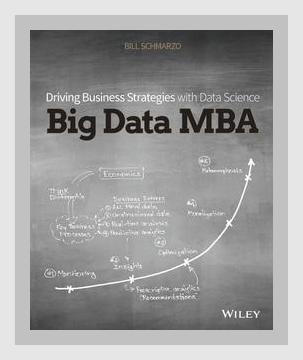Technology and Digital TransformationData Analytics
Introduction
In “Big Data MBA: Driving Business Strategies with Data Science,” Bill Schmarzo offers a blueprint for leveraging big data to drive business strategies. The book underlines the importance of data science in transforming raw data into actionable business insights. Schmarzo provides practical advice on integrating data analysis into corporate decision-making, supported by numerous real-world examples.
1. The Importance of Data Science in Business Strategy
Key Point:
Data science acts as a catalyst for business innovation and transformation.
Example:
Netflix uses big data to personalize its recommendations, thus enhancing user engagement and retention.
Actionable Step:
Implement Data-Driven Decision Making:
Leaders should emphasize fostering a data-driven culture within their organizations. Encourage the use of data analytics across departments to make decisions rooted in empirical evidence rather than intuition.
2. Building a Data Science Team
Key Point:
Successful data initiatives require a multidisciplinary team that includes data scientists, business analysts, and domain experts.
Example:
Schmarzo explains how a retail company implemented a data analytics project to improve inventory management by building a team comprising IT specialists, statisticians, and retail managers.
Actionable Step:
Create Cross-Functional Teams:
Assemble teams with diverse skill sets to cover all aspects of data analytics—from data collection and storage to analysis and application of insights in business contexts.
3. Identifying Business Use Cases
Key Point:
It is vital to identify specific business use cases where data analytics can provide tangible value.
Example:
A telecommunication company used data analytics to reduce customer churn by identifying at-risk customers and creating targeted retention strategies.
Actionable Step:
Conduct a Business Use Case Workshop:
Organize workshops involving key stakeholders to brainstorm potential areas where data analytics can be applied to solve business problems or optimize operations.
4. Data Collection and Management
Key Point:
Efficient data collection and management are foundational for any data science initiative.
Example:
Schmarzo discusses how Walmart has optimized its supply chain by collecting extensive data from sales transactions, inventory levels, and supplier performance.
Actionable Step:
Invest in Data Infrastructure:
Ensure the organization has robust data infrastructure in place, including databases, data lakes, and cloud storage solutions, to handle and process large volumes of data.
5. Data Analysis Techniques
Key Point:
Various data analysis techniques can be applied depending on the nature of the problem and the type of data available.
Example:
A manufacturing company used predictive analytics to anticipate machine failures, thereby reducing downtime and maintenance costs.
Actionable Step:
Employ Advanced Analytics:
Utilize techniques such as predictive modeling, machine learning, and statistical analysis to derive deeper insights from data. Continuously update and refine these models as new data becomes available.
6. Data Visualization
Key Point:
Data visualization is essential for communicating insights effectively to non-technical stakeholders.
Example:
A financial services firm improved its decision-making process by employing interactive dashboards that visualized key performance indicators (KPIs) and trends.
Actionable Step:
Adopt Data Visualization Tools:
Invest in visualization tools like Tableau, Power BI, or custom dashboards to make data insights accessible and understandable to all members of the organization.
7. Creating a Data-Driven Culture
Key Point:
For data initiatives to succeed, organizations must cultivate a culture that values data-driven decision-making.
Example:
Amazon integrates data-driven experimentation into its corporate culture, encouraging employees to test hypotheses and iterate based on data insights.
Actionable Step:
Promote Data Literacy:
Provide training programs to enhance data literacy across the organization. Encourage staff to appreciate the significance of data and to use it in their daily operations.
8. Aligning Data Projects with Business Goals
Key Point:
Data analytics projects must be aligned with the organization’s strategic goals to deliver maximum value.
Example:
A healthcare provider utilized data analytics to enhance patient care outcomes, aligning the project with its ultimate goal of improving patient satisfaction and health metrics.
Actionable Step:
Link Data Initiatives to Business Objectives:
When launching a data project, explicitly define how it supports key business objectives. This ensures that efforts are targeted and measurable.
9. Measuring the Impact of Data Initiatives
Key Point:
Continuous assessment and measurement of data initiatives are necessary to ensure they deliver expected business value.
Example:
A logistics company measured the success of its routing optimization project by tracking key metrics like fuel savings, delivery time reductions, and customer satisfaction.
Actionable Step:
Establish Metrics for Success:
Define clear, quantifiable metrics for assessing the impact of data projects. Regularly review these metrics to gauge performance and make necessary adjustments.
10. Overcoming Challenges in Data Science Implementation
Key Point:
There are several challenges in implementing data science projects, including data quality issues, resistance to change, and lack of expertise.
Example:
A company faced resistance from employees when a new predictive sales tool was introduced. Overcoming this required extensive training and clear communication of the tool’s benefits.
Actionable Step:
Address Barriers Proactively:
Anticipate common challenges and develop strategies to address them. Invest in quality data management practices, provide adequate training, and champion change management initiatives.
Conclusion
Bill Schmarzo’s “Big Data MBA” serves as a comprehensive guide for business leaders looking to harness the power of data science to drive strategic initiatives. The book emphasizes practical steps—from identifying business use cases and assembling the right team to fostering a data-driven culture and continuously measuring the impact of data projects. By following these guidelines, organizations can transform data into a strategic asset that fuels innovation and competitive advantage.
